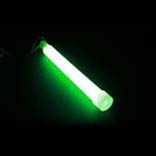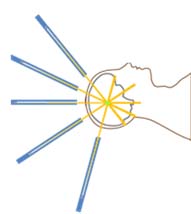Answer to Question #11740 Submitted to "Ask the Experts"
Category: Medical and Dental Patient Issues — Therapy - Radiation Oncology
The following question was answered by an expert in the appropriate field:
I had a Gamma Knife procedure with 16 gray (Gy) administered to my head. I was reading your website along with others, and I found a chart that compares radiation levels. According to http://chernobylgallery.com/chernobyl-disaster/radiation-levels, I have had 16,000 microsieverts (µSv) administered. Exactly how is this not fatal to the surrounding area—why is only one part of the body affected by the Gamma Knife? For instance, if the atomic bomb and Chernobyl produced less radiation, how is a Gamma Knife able to keep radiation in one location of the body?
First, I would like to distinguish the difference between radiation and radioactivity. Think about a glowstick.

The light from the glowstick is actually a form of radiation and is analogous to gamma radiation for this explanation. The liquid inside the plastic container is analogous to radioactivity. I can direct the light beam by putting the glowstick into an opaque tube with a hole in one end. This is what the Gamma Knife does. The Gamma Knife's radioactivity is inside small stainless steel containers. The stainless steel containers and radioactivity resemble pellets.
In the Gamma Knife, around 200 (the exact number depends on the Gamma Knife model) pellets of cobalt-60 (60Co) are used as sources of gamma radiation. The gamma radiation from each pellet is shaped into a narrow beam using material that absorbs gamma radiation (e.g., lead and tungsten), just like the opaque tube absorbs the glowstick light in all directions except one. This is called collimation. Each narrow beam is aimed at the brain tumor that is to be treated. The radiation dose to the tumor is the sum of the dose from each beam (16 Gy) with about 0.08 Gy being delivered by each beam. The surrounding tissue receives only the dose from one beam (well actually, a little bit more because of "scattering"). The image below is a two-dimensional representation of what is happening in three dimensions.

Kent Lambert, CHP, FHPS


